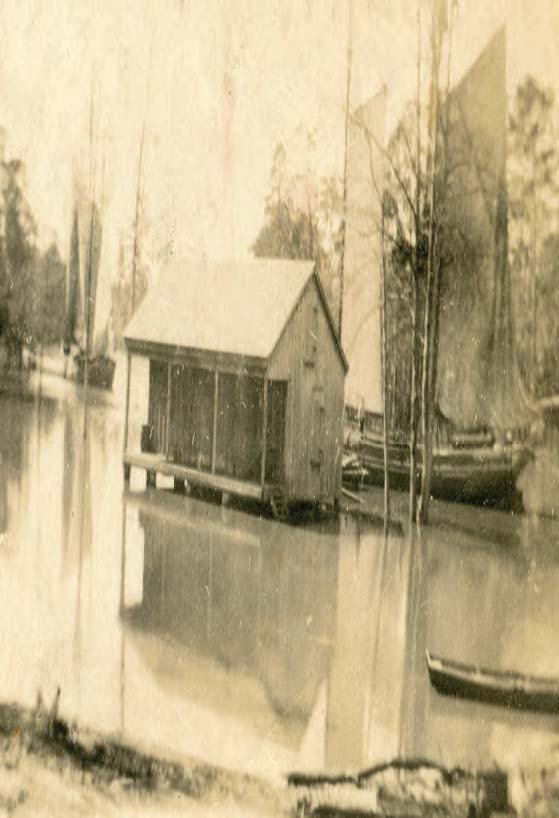
This article was originally written by Paige Gutierrez with the title "Woolmarket Memories". Paige is a local Biloxi writer, for BNews Monthly, the monthly newsletter of the City of Biloxi. All images courtesy of the Local History and Genealogy Department / Biloxi Public Library / Harrison County Library System.
Driving from Biloxi to Woolmarket, 1939
In 1939 the Woman’s Club of Gulfport partnered with President Franklin Roosevelt’s Federal Writers Project to create a book about the Mississippi Gulf Coast — part history and part tour guide. The result, Mississippi Gulf Coast, Yesterday and Today, 1699-1939, includes a suggested driving tour from Biloxi to Woolmarket, the Biloxi River country and beyond. Here are highlights of the journey as described by the book’s authors.
Going Across the Bay
Th e excursion starts at the north end of Caillavet Street, where a two-lane bridge across Back Bay links to D’Iberville. This is old Highway 55.
e excursion starts at the north end of Caillavet Street, where a two-lane bridge across Back Bay links to D’Iberville. This is old Highway 55.
Biloxi’s Back Bay neighborhood reminds the writer of “a European fishing village.” Boat builders work under the shade of oak trees on the shore, as well as on the shore “across the bay” in D’Iberville. Of D’Iberville the writer says “the village, with its old, white houses, remains distinctively French. Succeeding generations have followed in the footsteps of their forebears, engaging mostly in boatbuilding and fishing.”
After D’Iberville, the road passes through pecan orchards and a turpentine camp. The asphalt highway ends at the wooden drawbridge that crosses the Tchoutacabouffa River at Cedar Lake.
PHOTO - A scene from Old Woolmarket Road, date unknown. Old Woolmarket Road was once a part of the Caravan Route into the Piney Woods, according to Lulu Stiglets Martin in her oral history interview with Murella Powell of Biloxi Library, 1986. Biloxi Library Local History and Genealogy Collection.
Cut-over forests and new orchards
After seven miles of sand and gravel road through “cut-over land studded with small growths of pine and palmetto,” the traveler passes the turn to the Biloxi Unit of De Soto National Forest, established in 1934. After that intersection, there are more pecan and fruit orchards planted on cut-over land, before arriving at Woolmarket.
Woolmarket and Wool
At the time the tour guide was written in the late 1930s, Woolmarket was a “quiet, unincorporated agricultural area” of “stoutly built farmhouses surrounded by pecan orchards and fertile farms, one of Harrison County’s most productive agricultural sections.”
However, in the late 19th and early 20th centuries, it had been a busy center for the wool industry, as well as a river trading port that linked the Piney Woods to the Gulf Coast.
Sheep had once roamed freely on the coastal meadows and pine forests, where the understory was open for easy grazing. Each spring wool buyers from all over the country came to Woolmarket for the auction. Boston’s leading wool buyers paid a premium for Harrison County’s wool, as it was deemed superior, clean and free of briars. Harrison County produced a half million pounds of wool annually in the 1890s.
Stiglets’ Landing and the Caravan Route
S tiglets’ Landing on the Biloxi River was a significant trading port for the central Gulf Coast. In the days before railroads, sailing schooners carried freight over shallow coastal waters to Stiglets’ Landing, where goods came in from the Piney Woods to the north on the Caravan Route.
tiglets’ Landing on the Biloxi River was a significant trading port for the central Gulf Coast. In the days before railroads, sailing schooners carried freight over shallow coastal waters to Stiglets’ Landing, where goods came in from the Piney Woods to the north on the Caravan Route.
The old Caravan Route began as a cleared right of way before the Civil War for a railroad that was never built. People of the Piney Woods took advantage of this easy path south to Stiglets’ Landing with teams of oxen carrying farm products, wool, lumber, rosin, charcoal and beeswax to be loaded on schooners sailing to New Orleans and Mobile. For their return trip home – for some, as far north as Hattiesburg – they carried household goods from the port cities. Stiglets’ Landing at its busiest employed 500 men in shipping and logging, but by 1939 remnants of the old port were unused.
PHOTO - View of Stiglets' Landing, with schooners in the background. Biloxi Library Local History and Genealogy Collection.
Coalville and Beyond
The driving tour includes Coalville, the oldest settlement in the Woolmarket region, where charcoal makers tended their kilns beginning in the early 1800s. The Coalville Methodist Church, organized in 1852, served the pioneer community. After Coalville, the tour proceeds through the formerly bustling river trading post of Lorraine, down through more cut-over forest, past Handsboro and its cemetery, crosses the wooden bridge over Bayou Bernard before finally heading south toward the Mississippi Sound. The tour ends when the road reaches the beachfront at Highway 90.
Visit our Shop page to order wild-caught Gulf shrimp to be shipped to anywhere in the country today!
